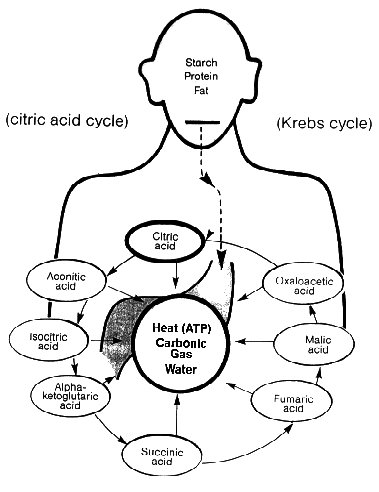

THE CITRIC ACID CYCLE
Look at the top of the diagram and you can see that all three major food groups are capable of entering the "CITRIC ACID CYCLE".
PROTEINS...in the form of amino acids enter the cycle in four different ways. Of the twenty-one amino acids used in human metabolism, ten are capable of entering the cycle and producing energy.
CARBOHYDRATES...note that almost all of the byproducts of carbohydrate metabolism are able to enter the cycle. This is the main source that the body uses to produce energy.
FATS...in the form of glycerol, cholesterol and triglycerides produce fatty acids that can also enter the cycle.
Energy can be produced in two different ways. One of them, and by far the most efficient way, is through the "CITRIC ACID CYCLE". The other pathway through which energy is produced is called "THE EMBDEN MEYERHOF PATHWAY". When the body cells do not have sufficient material to operate the Citric Acid Cycle, it then turns to this alternative pathway to produce energy.
HOW AND WHERE DOES THE "CITRIC ACID CYCLE" OPERATE?
In each cell of the body there are submicroscopic organelles (little organs). Each cell has thousands of these organelles that are divided into a number of different types. In one of these, the "mitochondria", most of energy that we use is produced. It is inside the mitochondria that the Citric Acid Cycle functions. The products of protein, carbohydrates and fat metabolism enter the mitochondria where most enter the Citric Acid Cycle in the form of Pyruvic Acid. These mitochondria metabolize into pyruvic acid and combine with Oxaloacetic Acid to form Citric Acid. Citric Acid then runs through a complex series of biological oxidations to produce free hydrogen ions (H +).
The hydrogen ions then enter a biochemical chain, known as OXIDATIVE PHOSPHORYLATION, which produces ATP (Adenosine Triphosphate). ATP is the molecule that all cells use for energy. For each molecule of Citric Acid that rotates through the Citric Acid Cycle, "THIRTY EIGHT" (38) ATP’s are produced. If oxygen, Citric Acid or the products from which Citric Acid is derived are unavailable, the cell must shift its energy production from the Citric Acid Cycle to the Embden Meyerhof Pathway. In this pathway only TWO (2) molecules of ATP are produced from each molecule of food that is utilized.
Thus one can see, the Citric Acid Cycle will produce NINETEEN TIMES more energy than the Embden Meyerhof Pathway. As well as producing much less energy, the Embden Meryerhof Pathway produces LACTIC ACID (a bad acid) as one of its byproducts. LACTIC ACID IS A METABOLIC WASTE THAT PRODUCES PAIN AND INFLAMMATION. We all have had the experience of exercising, or working harder than we are accustomed to, and developing aching muscles the next day. These aches and pains are the result of a buildup of Lactic Acid in the tissues. Many of the day to day aches and pains that we encounter are caused by an excess of bad acids, the primary one being LACTIC ACID.
WHAT ARE ACIDS? HOW DO THEY HELP AND HINDER HUMAN METABOLISM?
Acids are defined as any organic substance capable of giving up a
hydrogen ion such as
H PLUS (H +). In some situations, such as the Citric Acid Cycle, hydrogen ions are able to
interact in a positive way. By donating a single electron they are able to produce the
energy that enables the body to move, think, reproduce and heal itself. Having donated its
extra electron, the hydrogen ion is now capable of participating in the buffering systems
in our body.
Most metabolic waste products are acids that are not capable of
producing energy. These acids must be eliminated or buffered. If one of these two
processes does not occur, these acids then become one of the primary sources of human
illness. The Citric Acid Cycle, being able to free hydrogen ions (H +) of its electron is
also one of the major buffering systems of the body.
When we are acidic, we are not able to oxygenate our tissues properly, our circulation is impaired and all our organs function in an inefficient manner. Furthermore, the presence of acids tend to predispose the body toward the production of more bad acids that ultimately can lead to a complete breakdown of all of the metabolic functions. Most likely, the most important function of Citric Acid is in the production of energy as we have just outlined. However, this is not its only function.
Citric Acid acts directly in the production of ADRENALINE, one of the primary hormones used in stimulating the body defenses. It also participates in the production of CORTISOL, another hormone produced by the adrenal glands. CORTISOL is extremely important in stimulating the IMMUNE SYSTEM and it is known to be one of the body's MOST POTENT ANTI-INFLAMMATORY AGENTS.
Citric Acid is also used in the production of our SEX HORMONES. Both TESTOSTERONE AND ESTROGEN are dependent on it for their synthesis. Normal sexual functions depend upon having adequate levels of these two hormones. Almost all our vital functions are dependent on Citric Acid. Without it we could not live. To breathe, digest our foods, eliminate waste and reproduce, we must be able to maintain adequate levels of this most important nutrient.
The preceding article was written by: Ronald Wurtzbaugh, M. D., at the time written he was a resident of Palo Alto, California.
